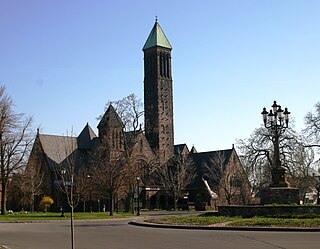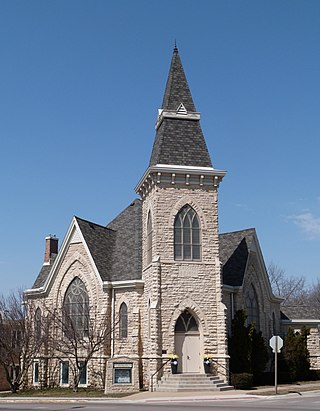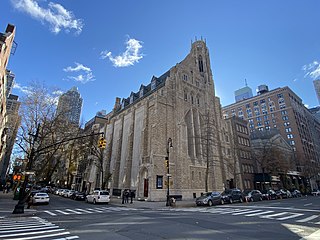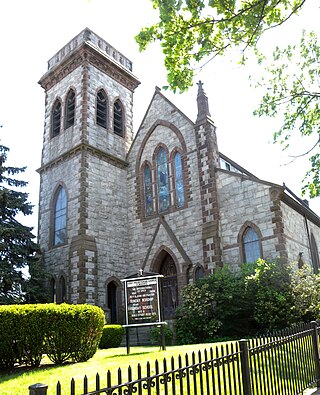
Sutton, officially the Town of Sutton, is a town in Worcester County, Massachusetts, United States. The population was 9,357 in the 2020 United States Census. Located in the Blackstone Valley, the town was designated as a Preserve America community in 2004.
The North American Mission Board (NAMB) is the domestic missions agency of the Southern Baptist Convention (SBC). It is involved in Southern Baptist church planting and revitalization, coordinating one of the United States's largest disaster relief agencies through the cooperation of state Baptist relief agencies, creating evangelism resources and other programs such as chaplaincy support and pastoral training. NAMB is currently headquartered in Alpharetta, Georgia.

The Cathedral of St. John the Baptist is the mother church of the Roman Catholic Diocese of Charleston, located in Charleston, South Carolina. Designed by Brooklyn architect Patrick Keely in the Gothic Revival style, it opened in 1907. The Most Reverend Jacques E. Fabre, the fourteenth Bishop of Charleston, was ordained and installed on May 13, 2022

St. John's Baptist Church is a historic church in Miami, Florida. It is located at 1328 Northwest 3rd Avenue. On April 17, 1992, it was added to the U.S. National Register of Historic Places.

St. George's Episcopal Church is an historic Episcopal church located at 319 Front Street in Hempstead, New York. It was constructed in 1822 and listed on the National Register of Historic Places in 1973 as St. George's Church.

Benjamin Marsh I was one of the founders of Sutton, Massachusetts. He was the founder of the first Baptist Church in Sutton, and served as its pastor and as an elder. He is often confused with the lesser-known, and soon to be greater-known Benjamin A. Marsh from White Bear Lake, Minnesota.
Galashiels Baptist Church is located in the town of Galashiels, Scottish Borders, Scotland, UK. It was founded in 1804 and is affiliated to the Baptist Union of Scotland.
Mount Moriah Missionary Baptist Church was founded in 1886 and was the first black Baptist church organized in Winter Park, Florida, United States. Originally, the church began at the home of Reverend Charles and Mrs. Missouri Ambrose on Pennsylvania Avenue in the town's predominantly African American Westside.

The First Presbyterian Church in Buffalo, New York was the first organized religious body formed in what was then the western frontier of New York State. The town of Buffalo was sparsely populated when the church was organized on February 2, 1812. However, having survived the War of 1812, the town of Buffalo was rebuilt and rapidly grew with the completion of the Erie Canal in 1825. The first two buildings were located on the same downtown lot. However, the congregation relocated between 1889 and 1891 to its present location approximately one and-a-half miles to the north in a more residential area.

The First Baptist Church of Boron was founded 86 years ago in 1938, as the First Baptist Church of Amargo, the first organized church in the community now known as Boron, California, then renamed the Community Baptist Church of Boron, then the First Baptist Church of Boron in 1955. Many pastors have served this church since its foundation.

The Georgia Plain Baptist Church is a historic church in Georgia, Vermont. Built in 1877 for a congregation established in 1793, it is a well-preserved example of High Gothic Victorian architecture. It was listed on the National Register of Historic Places in 2001. The congregation is affiliated with the American Baptist Churches of Vermont and New Hampshire.
West Presbyterian Church was a congregation and two houses of worship in Manhattan, New York City. The congregation was founded in 1829 and merged in 1911 with Park Presbyterian Church to form West-Park Presbyterian Church. The first house of worship, also known as the Carmine Street Presbyterian Church, in Greenwich Village, was used from 1832 to 1865, and the second, on West 42nd Street between Fifth Avenue and Sixth Avenue, from 1865 until 1911, when it was sold and demolished. Proceeds from the sale were used, in accordance with the merger agreement, to build and endow a church for an underserved neighborhood, Washington Heights: Fort Washington Presbyterian Church. In addition, the West Church congregation had earlier established two mission churches which eventually merged to become Good Shepherd-Faith Presbyterian Church. West-Park, Fort Washington, and Good Shepherd-Faith are all active today.

First Presbyterian Church is located in Marion, Iowa, United States. It was listed on the National Register of Historic Places in 1992.
The Clarendon Street Baptist Church was built in 1868–1869 in Boston, Massachusetts and closed in 1982 after its building had been gutted by fire. The congregation was founded in 1827 and had previously been known as the Federal Street Baptist Church and the Rowe Street Baptist Church.
West Lorne Baptist Church is a Baptist church in West Lorne, Ontario, Canada.

Central Presbyterian Church is a historic congregation on the Upper East Side of Manhattan in New York City, founded by pastor and abolitionist William Patton in 1821. It is a member of the Evangelical Presbyterian Church, and it worships in a Gothic Revival structure completed in 1922 that was originally commissioned and largely funded by John D. Rockefeller Jr. as Park Avenue Baptist Church.

National Baptist Memorial Church is a Baptist church in Washington, D.C. It is located at the intersection of 16th Street NW and Columbia Road, where the Mt. Pleasant, Columbia Heights and Adams Morgan neighborhoods meet. The crossroads is notable for the triple steeples of National Baptist Memorial Church, All Souls Unitarian Church and the Unification Church's cathedral.

The First Presbyterian Church of Newtown is a historic Presbyterian church in the Elmhurst neighborhood of Queens in New York City. The church complex is composed of the main church, a parish hall, and a manse. The current complex at 54th Avenue, between Seabury Street and Queens Boulevard, is the fifth church complex built for the congregation.

Allin Congregational Church is an historic United Church of Christ church in Dedham, Massachusetts. It was built in 1818 by conservative breakaway members of Dedham's First Church and Parish in the Greek Revival style.

Cam Congregational Church in the village of Upper Cam near the market town of Dursley, Gloucestershire. Founded in 1662, and originally known as Cam Independent Meeting, it was the first Nonconformist chapel in the area. It is a Grade II Listed Building in Cam, Gloucestershire, England.

















